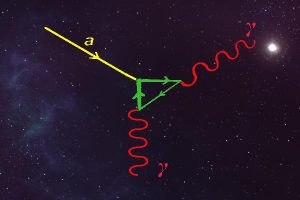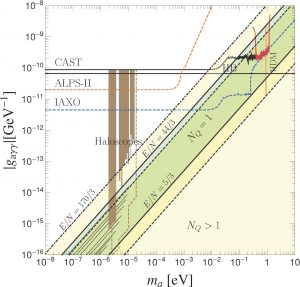
During the past decades, a plethora of experimental results has firmly established that strong interaction phenomena in particle physics are correctly described by a theory known as Quantum Chromo Dynamics (QCD). While to date there are no experimental results contradicting QCD predictions, this beautiful theory, together with a deep understanding of many fundamental issues, also brings in one theoretical conundrum. QCD depends on two dimensionless fundamental parameters whose value is not predicted by the theory, but must be determined experimentally. The first one, $α_{s}$, determines the strength of the QCD interactions, and its experimental value is a natural one for a dimensionless quantity (roughly speaking it is of order unity, although the precise number depends on the energy scale at which $α_{s}$ is measured). The second one, θ, gives the amount of violation of the charge-parity (CP) symmetry in strong interactions. The theory only dictates that the value of θ, which is an angular parameter, must range within the interval [-π, π], and also in this case it would be natural to expect a value roughly of order unity. Surprisingly, it is found instead that the absolute value of θ must be smaller than 10-10 , as is implied by the stringent experimental limits on the neutron electric dipole moment, which is a CP violating quantity. Such a tiny value is regarded as highly unnatural for a dimensionless parameter, and it would definitely be more natural if, for some reason, θ = 0. This would straightforwardly imply that QCD is a CP conserving theory, in agreement with observations.
An elegant mechanism to guarantee the vanishing of θ was proposed in 1977 by Roberto Peccei and Helen Quinn. The Peccei-Quinn (PQ) mechanism implies the existence of a particle of zero spin and, in first approximation, of zero mass, which is commonly referred to as the axion. There are, however, subtle corrections to the first order approximation, which imply that the axion is not exactly massless, but it acquires a tiny mass $m_{a}$, presumably even smaller than the mass of the neutrinos. Soon after the PQ mechanism was proposed, it was realised that the same dynamical phenomenon which drives θ to zero, also implies that a population of zero momentum axions is generated from the vacuum, and these axions would pervade today the whole observable Universe. Noteworthy, for a certain range of axion masses, well compatible with theoretical expectations, this `sea’ of axions could provide the cosmological dark matter. Clearly the fact that axion models can naturally provide a dark matter candidate enhances the theoretical appealing of the PQ mechanism and justifies the several axion search experiments that are being planned for the next future.
One of the most peculiar property of axions is that they couple to a pair of photons (see fig. 1). While the strength of the axion-photon coupling $g_{aγγ}$ is model dependent, virtually all ongoing search experiments rely on axion-photon conversion which is mediated by this coupling. Clearly, the goal of axion searches is to reach inside the parameter space region (in the $g_{aγγ}$ – $m_{a}$ plane) where realistic axion models live. Currently, however, the boundaries of this region are fixed on the basis of somewhat arbitrary criteria.
The problem of defining on a more solid phenomenological basis the region inside which axion searches should focus, has been recently addressed by Luca Di Luzio (Durham University), Federico Mescia (Barcellona University), and Enrico Nardi (LNF). The results of this research have been published in the one of the last issues of the renowned Physical Review Letters, and the article was highlighted as a Physical Review Letters Editors’ suggestion.

The authors proceeded to classify a large set of axion models, selecting as phenomenologically preferred those that do not give rise to cosmological issues (in the form of cosmologically stable strongly interacting relics), and where the strength of the interactions between the known particles (for example the leptons and the quarks) does not become infinite below the Planck energy. The authors have identified fifteen cases that satisfy these criteria. They define a phenomenologically preferred axion window, which is delimited with the two continuous lines in Fig. 2, labeled E/N=44/3 and E/N=5/3. (For comparison, the region that was so far considered as the most interesting is also depicted, enclosed between the two dashed lines). By combining among them the fifteen models, other possibilities that still satisfy the two conditions can be constructed. They span the larger region colored in the figure in light yellow, which is delimited by the dot-dashed line labeled E/N=170/3. Within this enlarged region, enhancements of the axion-photon couplings of almost one order of magnitude are possible. However, in a few cases it can also happen that the axion decouples almost completely from the photon, so that the region has no lower boundary.
It is expected that this analysis will contribute to focus the experimental efforts for axion searches towards the parameter space region encompassing the phenomenologically most appealing axion models.
The article is freely available at: https://arxiv.org/abs/1610.07593 (Enrico Nardi)
 INFN-LNF Laboratori Nazionali di Frascati
INFN-LNF Laboratori Nazionali di Frascati